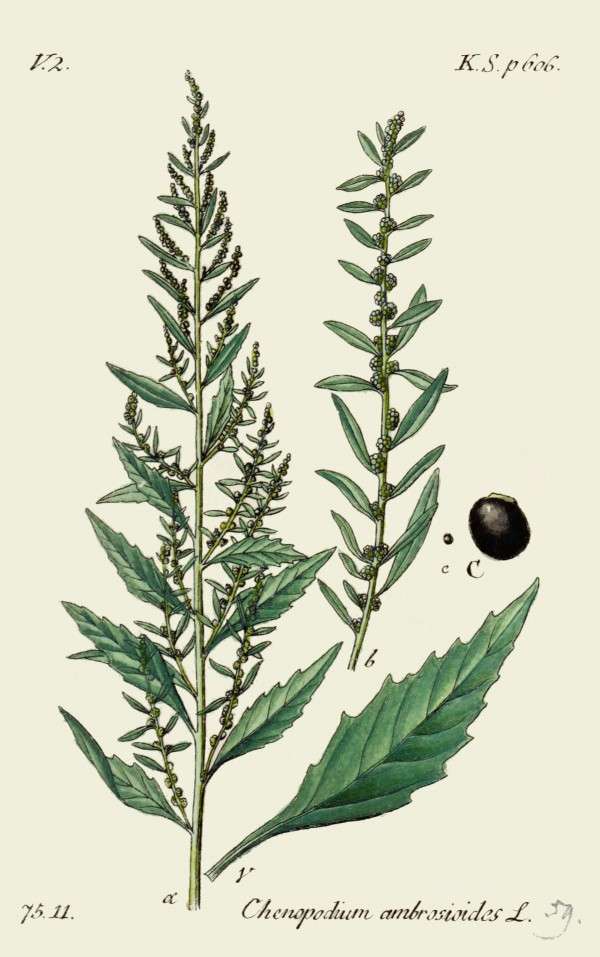Dies ist eine alte Version des Dokuments!
Dysphania ambrosioides (L.) Mosyakin & Clemants - syn.Chenopodium ambrosoides L. - Chenopodiaceae
epazote (span.), Mexiacan tea, American wormseed, Mexikanischer Tee, Wohlriechender Gänsefuß
Annual to short-lived perennial, strongly aromatic, up to 1m high, native to the tropic and subtropic Americas, naturalized and cultivated elsewhere; leaves lanceolate to elliptic, irregularly coarsely serrate; flowers small, green, inflorescence paniculate.
http://www.efloras.org/florataxon.aspx?flora_id=5&taxon_id=200006810
„Epazote is used as a leaf vegetable, an herb and an herbal tea for its pungent flavor. Raw, it has a resinous, medicinal pungency, similar to anise, fennel, or even tarragon, but stronger. Epazote's fragrance is strong but difficult to describe. A common analogy is to turpentine or creosote. It has also been compared to citrus, savory, or mint… In the early 1900s it was one of the major anthelmintics used to treat ascarids and hookworms in humans, cats, dogs, horses, and pigs.“
https://en.wikipedia.org/wiki/Dysphania_ambrosioides
„The usage of wormseed oil on humans is limited by the toxicity of ascaridole and has therefore been discouraged. In high doses, wormseed oil causes irritation of skin and mucous membrane, nausea, vomiting, constipation, headache, vertigo, tinnitus, temporary deafness and blindness.“
https://en.wikipedia.org/wiki/Ascaridole
„Ethnopharmacological studies in a community of Mayan subsistence farmers in Chiapas, Mexico, confirmed that decoctions containing up to 300 mg of dry plant material per kg body weight (MGKGW) were widely used and traditionally highly regarded in the treatment of ascariasis.“
[Studies on the traditional herbal anthelmintic Chenopodium ambrosioides L.: Ethnopharmacological evaluation and clinical field trials., Kliks, M.M., Social Science & Medicine, Vol.21(8), 1985, 879-886]
„Essential oil extracted from the leaves of Chenopodium ambrosioides Linn. (Chenopodiaceae) was tested against the aflatoxigenic strain of test fungus Aspergillus flavus Link. The oil completely inhibited the mycelial growth at 100 μg/ml. The oil exhibited broad fungitoxic spectrum against Aspergillus niger, Aspergillus fumigatus, Botryodiplodia theobromae, Fusarium oxysporum, Sclerotium rolfsii, Macrophomina phaseolina, Cladosporium cladosporioides, Helminthosporium oryzae and Pythium debaryanum at 100 μg/ml. The oil showed significant efficacy in inhibiting the aflatoxin B1 production by the aflatoxigenic strain of A. flavus. During in vivo investigation it protected stored wheat from different storage fungi for one year.“
[Evaluation of Chenopodium ambrosioides oil as a potential source of antifungal, antiaflatoxigenic and antioxidant activity., Kumar, R., Mishra, A.K., Dubey, N.K., Tripathi, Y.B., International Journal of Food Microbiology, Vol.115(2), 2007, 159-164]
„The antifungal activity of essential oil (EO) from the Brazilian epazote (Chenopodium ambrosioides L.) was evaluated by the poison food assay at concentrations of 0.3%, 0.1%, and 0.05% with eight postharvest deteriorating fungi (Aspergillus flavus, Aspergillus glaucus, Aspergillus niger, Aspergillus ochraceous, Colletotrichum gloesporioides, Colletotrichum musae, Fusarium oxysporum, and Fusarium semitectum). EO components were tentatively identified by Kováts retention indices (RIs) using gas chromatography and gas chromatography combined with mass spectrometry (GC-MS). Growth of all fungi was completely inhibited at 0.3% concentration, and by 90% to 100% at 0.1% concentration. The following 13 tentatively identified compounds (relative percent) accounted for 90.4% of the total volatile oil: α-terpinene (0.9), p-cymene (2.0), benzyl alcohol (0.3), p-cresol (0.3), p-mentha-1,3,8-triene (0.2), p-cimen-8-ol (0.6), α-terpineol (0.5), (Z)-ascaridole (61.4), piperitone (0.9), carvacrol (3.9), (E)-ascaridole (18.6), (E)-piperitol acetate (0.5), and (Z)-carvyl acetate (0.3). Autobiographic thin layer chromatography of the EO to separate the principal fungitoxic fraction yielded only one fraction that completely inhibited the growth of all test fungi at a concentration of 0.1%. This fraction was characterized by RIs and GC-MS presenting a composition (%) of p-cymene (25.4), (Z)-ascaridole (44.4), and (E)-ascaridole (30.2). The results suggest ascaridoles were the principal fungitoxic components of the EO.“
[Composition and antifungal activity of the essential oil of the Brazilian Chenopodium ambrosioides L., Jardim, C.M., Jham, G.N., Dhingra, O.D., Freire, M.M., Journal of chemical ecology, Vol.34(9), 2008, 1213-1218]

Dysphania ambrosioides as Chenopodium ambrosioides
Sturm, J., Sturm, J.W., Deutschlands flora, vol.17 t.[59] (1838-1839)
http://www.plantillustrations.org/species.php?id_species=367220
